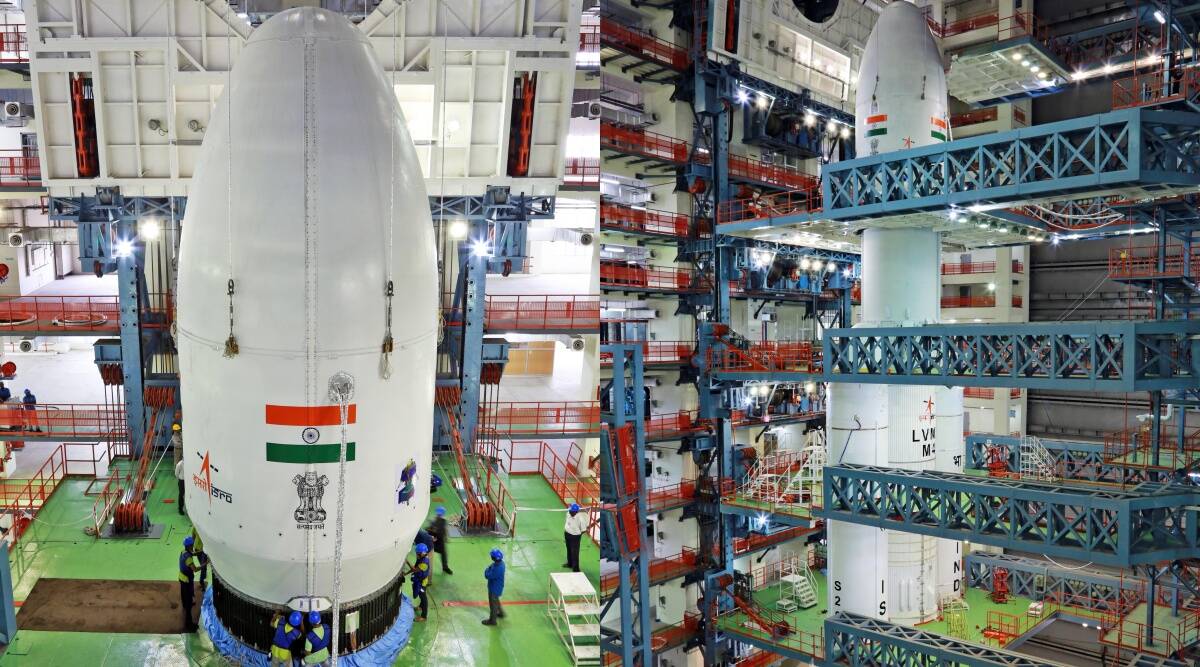
The Indian Space Research Organization (ISRO) on Wednesday attached the encapsulated assembly containing the Chandrayaan-3 spacecraft to its new launch rocket LVM3 at the Satish Dhawan Space Center in Sriharikota, Andhra Pradesh. Chandrayaan-3 is a follow-up mission to Chandrayaan-2, which is expected to demonstrate its full capability to safely land an instrument on the lunar surface and conduct exploration activities from it.
The Bangalore-headquartered national space agency tweeted that the encapsulated assembly containing Chandrayaan-3 was joined with LVM3 at the Satish Dhawan Space Center in Sriharikota today. ISRO has said that the Chandrayaan-3 mission will be launched between July 13 and July 19. An ISRO official said, "We aim to launch it on July 13."
The Chandrayaan-3 mission will carry instruments to study the thermophysical characteristics of the lunar crust, the frequency of lunar earthquakes, the plasma environment on the lunar surface, and the composition of elements near the landing site. According to ISRO officials, these scientific instruments mounted on the lander and rover will be under the theme 'Science of the Moon', while the experimental instruments to study Earth from lunar orbit will be under the theme 'Science from the Moon'.
Dr Sita, former director of ISRO's Space Science Program Office, told that Chandrayaan-3 will have a propulsion module, which will carry the lander and a rover and this will enable them to reach the lunar orbit.
"It is expected that the lander will land on the soft surface of the lunar polar region, and the rover will come out from it and start rotating on the lunar surface," he said. We expect it to observe the properties of the Moon's surface. Some 'payloads' will also go with the lander and they will also do various experiments on the surface and investigate.
According to Dr. Sita, the experiments will be carried out during one lunar day i.e. it will take about 30 Earth days. He said, after about 15 days there will be night and the temperature will drop to minus 170 degrees centigrade or less. The situation will change in the next 15 days. We cannot say how much and what effect the cold will have on the lander. But, the first 15 days will be very important.
In March this year, the Chandrayaan-3 spacecraft completed the required tests, during which the spacecraft's ability to withstand the harsh vibration and acoustic environment during launch was confirmed. These tests were particularly challenging, because the Chandrayaan-3 spacecraft, which will be launched by LVM3 (Launch Vehicle Mark-III) (earlier known as GSLV Mk III), will consist of three modules - Propulsion is a combination of lander and rover.
The lander will be equipped with the capability to soft-land on a specific spot on the Moon and deploy the rover, which will conduct chemical analysis on the lunar surface.
Bollywood's Dabangg Khan i.e. Salman Khan after the film 'Kisi Ka Bhai Kisi Ki Jaan' is now in di
The handshake controversy between India and Pakistan in the Asia Cup 2025 is still in the news. T
MS Dhoni: Defamation case filed against MS Dhoni, case to be heard in Delhi High Court on January 29
The Delhi High Court has adjourned till January 29 the hearing in the defamation case filed again
'Everyone should know Marathi in Maharashtra', hooliganism by MNS workers; slapped the shopkeeper.
The video of hooliganism by MNS leaders in the Mira Bhayander area of Maharashtra is going
G20: 'Instead of who is coming to G20, the focus should be on issues', S jaishankar's big statement
The absence of Russian President Putin and later Chinese President Xi Jinping has been confirmed
Harmanpreet Kaur shook the record books and set a record by scoring a century in England
Indian women's cricket team captain Harmanpreet Kaur created history by scoring a century against
In the knock-out match of Asia Cup 2023, Sri Lanka defeated Pakistan and knocked them out of the
Partnering for the first time with billionaire businessman Elon Musk, India will launch its commu
In Ultimate Table Tennis Season 4, the Mumbai team achieved its second consecutive victory. Mumba
Oscar Awards 2024: Everyone's eyes are on the Oscar Awards, one of the most important awards in t